The Jama Mosque Agra is a magnificent example of 17th-century mosque architecture, celebrated for its aesthetic beauty and cultural importance. Constructed in 1648 by Shah Jahan, the mosque is a tribute to his beloved daughter, Jahanara Begum. This remarkable structure, made of red sandstone, showcases Persian-style carvings, striking domes, and an expansive prayer hall. Situated in proximity to both Agra Fort and the Taj Mahal, it plays a crucial role in Agra’s Mughal heritage. Although it is one of India’s largest mosques, it continues to function as an active site of worship, drawing thousands of visitors each year.
Jama Masjid Agra Location
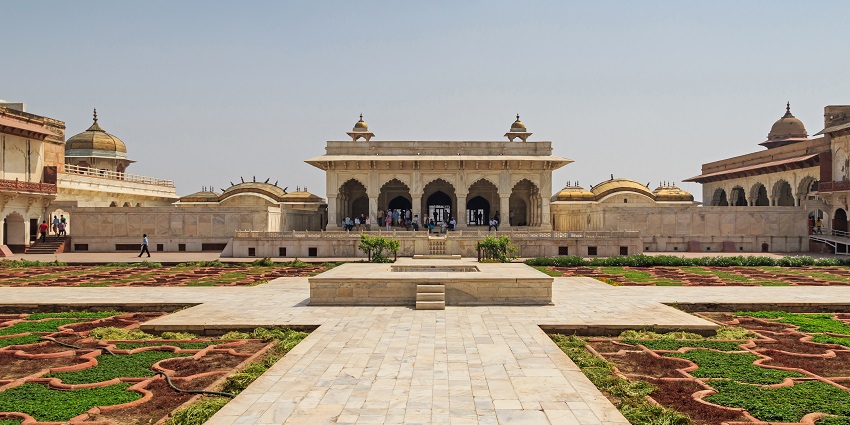
Photo: A.Savin / Wikimedia Commons / Image For Representation Only
The Jama Mosque Agra is an ideal option for tourists seeking to explore nearby attractions. Located merely a 15-minute stroll (about 1 km) from the renowned Taj Mahal, it is an addition to a heritage tour of Agra. Moreover, Agra Fort, which is another UNESCO World Heritage site, is roughly 500 meters from the mosque.
Suggested Read: Best Places For Shopping In Uttar Pradesh
How To Reach Jama Mosque Agra
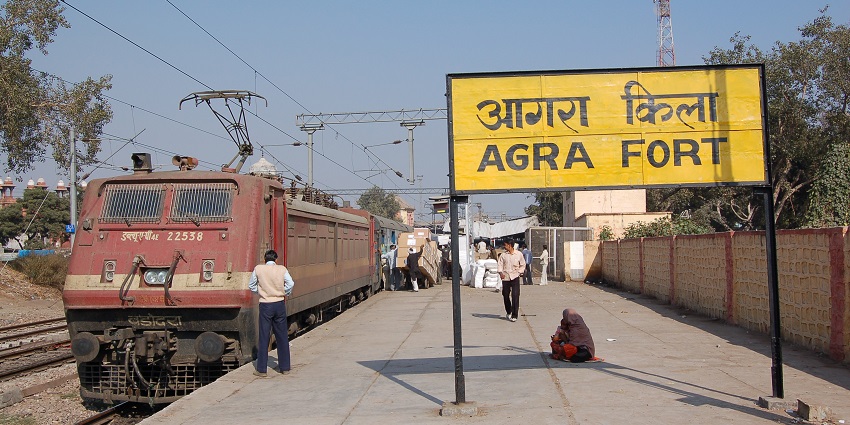
Photo: Bahnfrend / Wikimedia Commons / Image For Representation Only
Arriving at the Jama Mosque Agra is convenient due to the availability of several options to accommodate different travel preferences.
By Train: Travelling by train is a widely favoured option. Agra, for instance, has three significant railway stations: Agra Cantt, Agra Fort, and Raja Ki Mandi. Trains from Delhi, Jaipur, and other cities arrive regularly at three stations. However, Agra Fort Station is the nearest to the Jama Mosque. From Agra Fort Station, it is just a 5-minute ride by auto or taxi. This makes it easy for travellers.
By Air: For individuals travelling by plane, the closest airport is the Pandit Deen Dayal Upadhyay Airport, approximately 12 km from the mosque. Although its domestic connectivity is somewhat limited, the airport maintains a strong link with Delhi. Once at the airport, visitors can either hire a cab or utilise app-based taxis for a convenient 20-minute drive to Jama Masjid.
By Road: Agra is linked to Delhi and Jaipur through the Yamuna Motorway and the National Highway 11. A seamless drive of 3 to 4 hours from either Delhi or Jaipur makes it an optimal choice for a road trip. Local transport options, such as buses, autorickshaws, and taxis, offer access to the Jama Masjid.
The Top 5 Places To Visit Near Jama Mosque Agra
Explore the essential attractions situated near Agra’s renowned Jama Masjid. Perfect for immersing oneself in its vibrant culture and rich history.
1. Taj Mahal
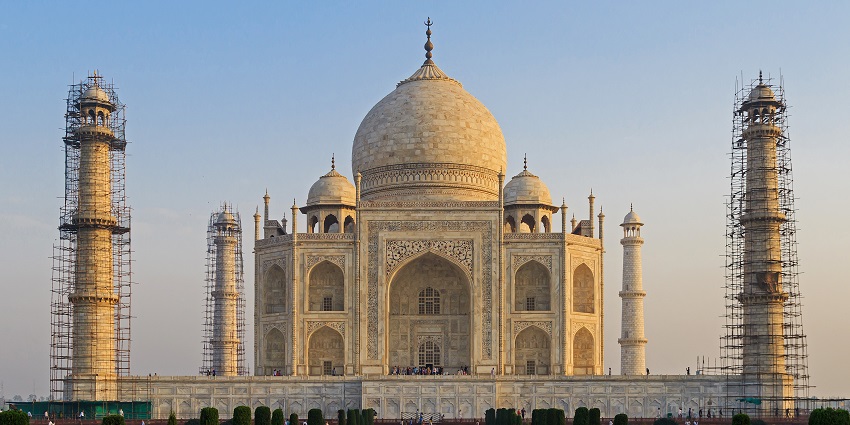
Photo: A.Savin / Wikimedia Commons
The Taj Mahal is one of the iconic emblems of India, situated merely a short distance from the Jama Masjid. Constructed in the 17th century by the Mughal Emperor Shah Jahan, it is dedicated to his wife, Mumtaz Mahal. This white marble structure, celebrated for its impeccable symmetry, is adorned with marble inlay work, which includes semi-precious stones and Persian inscriptions. Moreover, the central dome is surrounded by four domes and minarets.
Timings: Sunrise to Sunset
Entry Fee: ₹50 for Indian nationals, ₹1100 foreign nationals
Suggested Read: Saree Shopping In Varanasi
2. Agra Fort
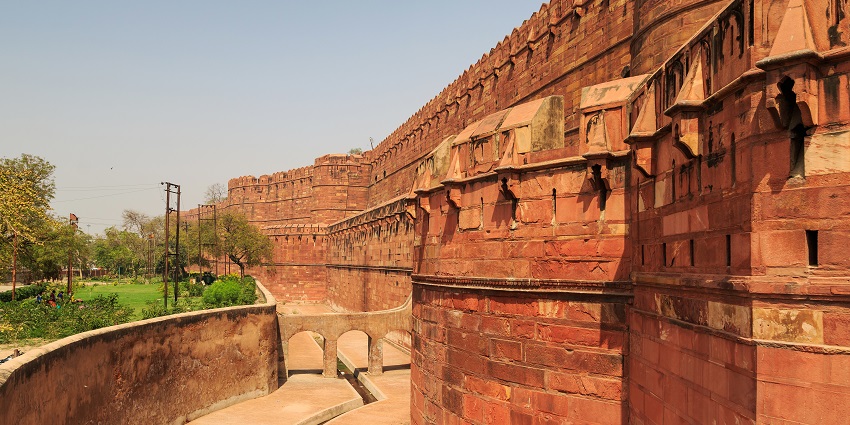
Photo: A.Savin / Wikimedia Commons
Agra Fort, situated near Jama Masjid, is recognised as one of Agra’s most remarkable Mughal monuments. Constructed in the 16th century by Emperor Akbar and subsequently altered by Shah Jahan, the fort functioned as an administrative centre of the Mughal Empire. Primarily composed of red sandstone, it has a diverse array of palaces, courtyards, mosques, and audience halls. Noteworthy locations within the fort are the Jahangir Mahal, the Diwan-i-Am, and the Diwan-i-Khas, where significant deliberations took place.
Timings: 6 AM – 6 PM
Entry Fee: ₹50 for Indian nationals, ₹600 for foreign nationals
3. Mehtab Bagh
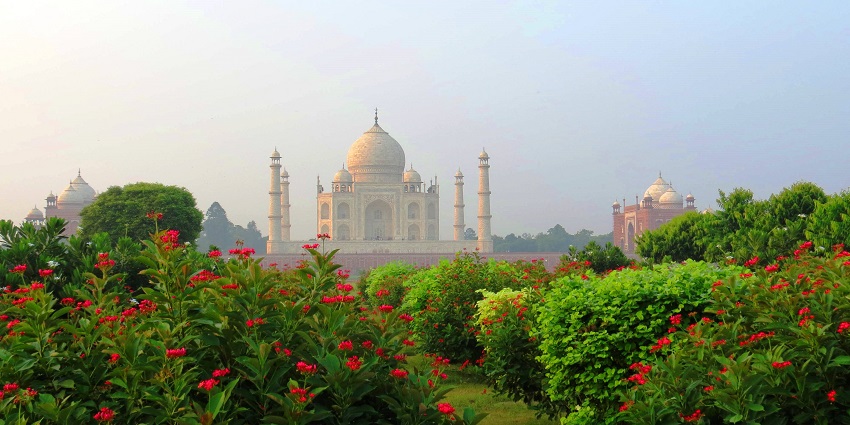
Photo: g.kaustav / Wikimedia Commons
Mehtab Bagh, often referred to as the “Moonlight Garden,” is situated across the Yamuna River from the Taj Mahal. Initially constructed by Emperor Babur, this garden later became a favourite destination for Emperor Shah Jahan. He envisioned it as the perfect vantage point for viewing the Taj Mahal. This square-shaped Charbagh garden was designed to mirror the symmetry of the Taj itself, aligning seamlessly with the monument’s remarkable architecture. The garden features pathways adorned with flowering plants, fruit trees, and verdant lawns, creating a beautiful foreground for the Taj Mahal, particularly at sunset. Overlooking the Yamuna River also offers a soothing environment for relaxation.
Timings: Sunrise to Sunset
Entry Fee: ₹25 for Indian nationals, ₹300 for foreign nationals
Suggested Read: Art Galleries In Uttar Pradesh
4. Itimad-ud-Daulah’s Tomb
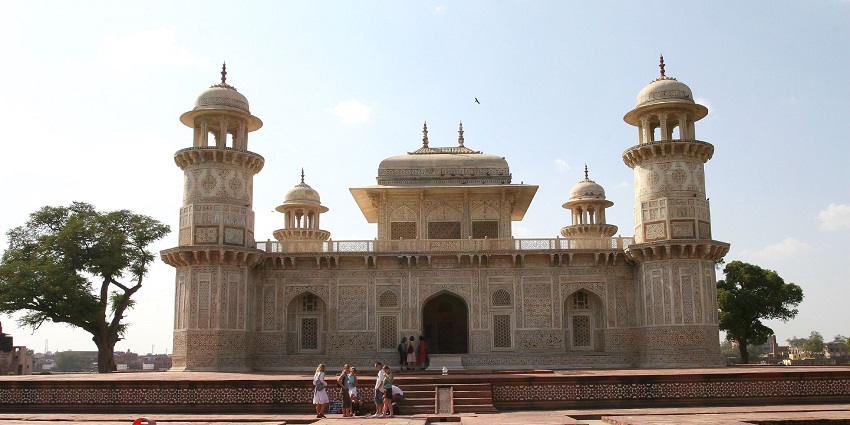
Photo: Bryan Allison / Wikimedia Commons
Itimad-ud-Daulah’s Tomb, often referred to as the “Baby Taj,” is one of the earliest Mughal monuments constructed entirely from white marble, predating the renowned Taj Mahal. Nur Jahan commissioned this smaller yet detailed tomb for her father, Mirza Ghiyas Beg. The architecture of the tomb signifies a notable transformation in Mughal design. It showcases exquisite inlay work using semi-precious stones, along with floral motifs and lattice screens. The tomb is surrounded by symmetrical gardens, which emphasise the Gurkhani affinity.
Timings: 6 AM to 6 PM
Entry Fee: ₹25 Indian national, ₹300 foreign nationals
5. Akbar’s Tomb Sikandra
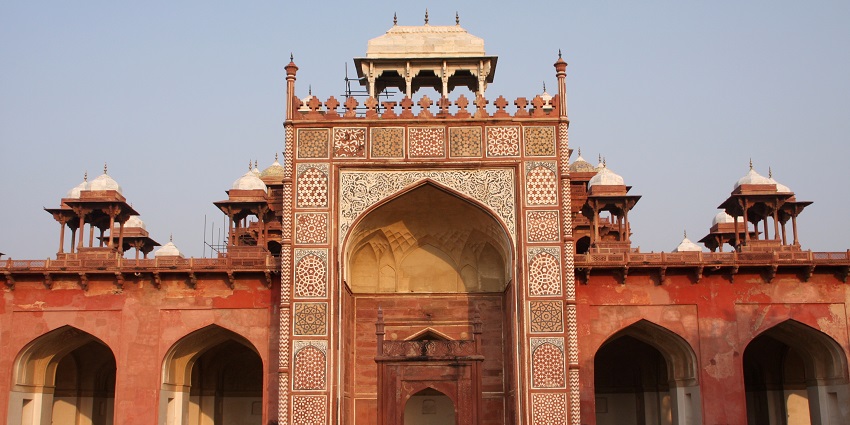
Photo: orvalrochefort / Wikimedia Commons
Akbar’s Tomb, situated in Sikandra approximately 10 km from Agra, is the final resting place of the third Mughal emperor, Akbar. This magnificent structure, encompassing 119 acres of gardens, embodies Akbar’s vision of inclusivity and architectural innovation, blending Hindu, Islamic, and Jain elements. Constructed from red sandstone and adorned with marble inlays, the tomb features four impressive gates. The most renowned one is the south gate, embellished with meticulous carvings.
Timings: Sunrise to Sunset
Entry Fee: ₹30 for Indian nationals, ₹310 for foreign nationals
Suggested Read: Top Noida Picnic Places
Where To Eat
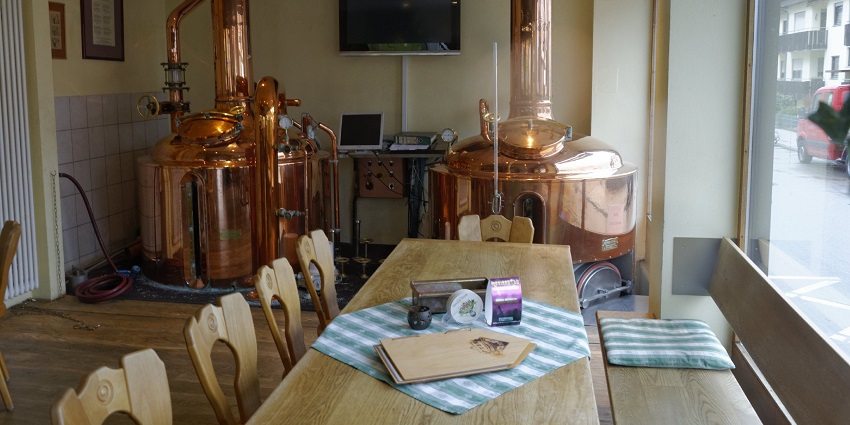
Photo: Ra Boe / Wikimedia Commons / Image For Representation Only
Agra offers a varied culinary experience that encompasses both traditional Mughlai cuisine and contemporary dishes. One notable establishment is Pinch of Spice, which is a favoured option located near the Taj Mahal. It offers an array of rich curries, kebabs, and biryani within a comfortable and modern ambience. However, for those seeking an authentic local experience, Joney’s Place serves traditional North Indian dishes, including fresh lassis that are quite refreshing.
Where To Stay
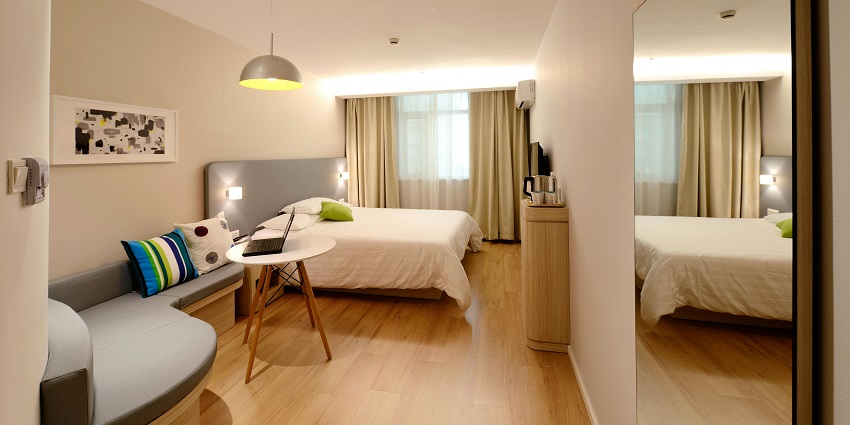
Photo: Pixabay / Pexels / Image For Representation Only
Agra provides accommodations catering to a wide range of budgets. For those seeking luxury, the Oberoi Amarvilas provides breathtaking views of the Taj Mahal, combined with exceptional service and amenities. ITC Mughal offers a unique fusion of Mughal-inspired architecture and modern luxury, featuring stunning gardens and a sizable pool. Hotel Taj Resorts serves as a mid-range option, conveniently located near the Taj Mahal, with comfortable rooms and a rooftop restaurant offering splendid views.
Suggested Read: Haunted Places In Noida For A Spooky Encounter
Best Time To Visit
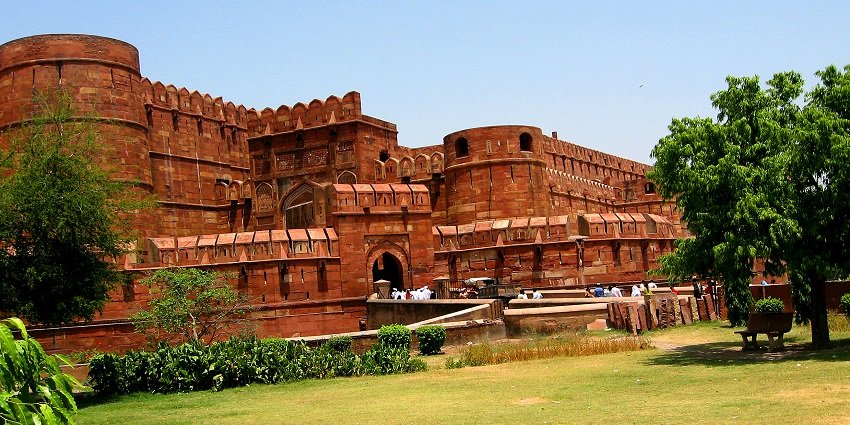
Photo: Slyronit / Wikimedia Commons / Image For Representation Only
The best time to visit Agra is between October and March, as the weather is significantly cooler. This makes outdoor sightseeing more pleasurable. During these months, temperatures typically vary from 8°C to 25°C, which is ideal for discovering the city’s historical landmarks. Winter mornings offer a stunning ambience at the Taj Mahal, with mild fog enhancing its beauty. Festivals such as Diwali and Taj Mahotsav in February contribute cultural richness to the overall experience.
Other Factors To Consider
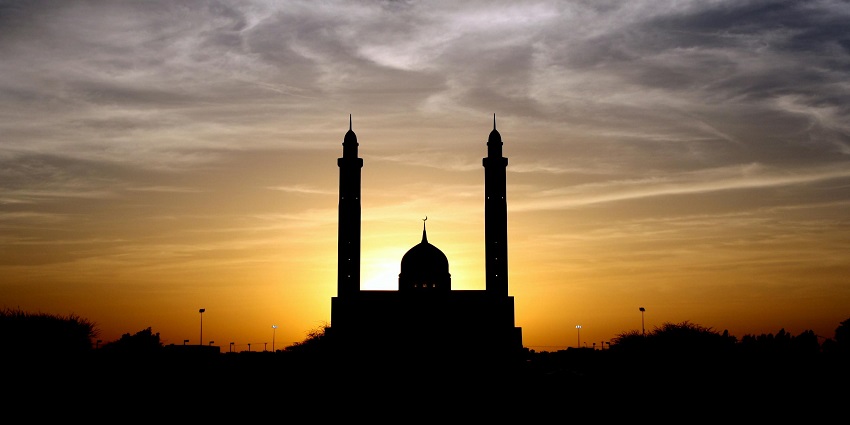
Photo: David McEachan / Wikimedia Commons / Image For Representation Only
When planning a visit to Jama Masjid in Agra, it is crucial to take into account the expenses involved with a few tips to improve your experience.
Average Cost Of The Trip
A journey to Agra that includes mid-range lodging, meals, transport, and entry fees generally costs between ₹5,000 and ₹10,000 daily for each individual. Budget-conscious travellers can reduce expenses by opting for hostels and dining at local establishments. In contrast, luxury tourists may expend more than ₹20,000 per day, primarily due to upscale hotels and gourmet dining.
Tips For Travellers
- Initiating your day at an early hour can help you circumvent crowds and obtain optimal views at renowned locations.
- Don comfortable footwear, as the attractions in Agra necessitate considerable walking.
- Honour local traditions. Since the Jama Masjid is a functioning site of worship, it is important to dress modestly and remove your shoes before entering.
- It is advisable to carry water bottles because Agra can be quite warm, even during the winter months.
- Capture the photos of Jama Masjid in the soft light of early morning to achieve the best clarity and detail.
Suggested Read: Places Near Lucknow For Weekend
Jama Mosque Agra, along with its surrounding historic sites, provides an in-depth exploration of India’s Mughal history. With detailed planning, effective budget management, and practical advice, visitors can truly enjoy a fulfilling experience. Are you ready to delve into Agra’s iconic heritage? Plan your journey with TripXL. They ensure a seamless and unforgettable adventure through India’s rich past and vibrant present.
Cover Photo: Iva Prime / Pexels / Image For Representation Only


 WhatsApp
WhatsApp
 Twitter
Twitter









